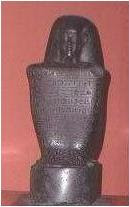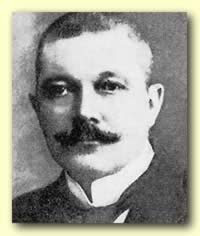 Pinouris, Son of Hor perches on top of a column in the east Library. Pa-iu-en-hor, known in Greek as Pinouris, was “God’s Father” and the “Prophet of Amun in Karnak.” Pinouris holds lettuce leaves in his hands, these are symbolic of fertility to the Egyptians. The three columns of text on the back pillar contain offering formulae and prayers. There are twelve lines on the front that contain prayers and autobiographical statements.
Pinouris, Son of Hor perches on top of a column in the east Library. Pa-iu-en-hor, known in Greek as Pinouris, was “God’s Father” and the “Prophet of Amun in Karnak.” Pinouris holds lettuce leaves in his hands, these are symbolic of fertility to the Egyptians. The three columns of text on the back pillar contain offering formulae and prayers. There are twelve lines on the front that contain prayers and autobiographical statements. This statue was made during the Ptolemaic dynasty when a Hellenistic royal family ruled the Ptolemaic Empire in Egypt for nearly 300 years. Ptolemy, a Mace donian and one of Alexander the Great’s generals, was appointed satrap (a Persian title for ruler) of Egypt after Alexander’s death. In 305 BC, he declared himself King Ptolemy I. The Egyptians accepted the Ptolemies as the successors to the pharaohs of independent Egypt. Ptolemy’s family ruled Egypt until the Roman conquest. The most notorious member of the line was the last queen, Cleopatra VII.
donian and one of Alexander the Great’s generals, was appointed satrap (a Persian title for ruler) of Egypt after Alexander’s death. In 305 BC, he declared himself King Ptolemy I. The Egyptians accepted the Ptolemies as the successors to the pharaohs of independent Egypt. Ptolemy’s family ruled Egypt until the Roman conquest. The most notorious member of the line was the last queen, Cleopatra VII.
 donian and one of Alexander the Great’s generals, was appointed satrap (a Persian title for ruler) of Egypt after Alexander’s death. In 305 BC, he declared himself King Ptolemy I. The Egyptians accepted the Ptolemies as the successors to the pharaohs of independent Egypt. Ptolemy’s family ruled Egypt until the Roman conquest. The most notorious member of the line was the last queen, Cleopatra VII.
donian and one of Alexander the Great’s generals, was appointed satrap (a Persian title for ruler) of Egypt after Alexander’s death. In 305 BC, he declared himself King Ptolemy I. The Egyptians accepted the Ptolemies as the successors to the pharaohs of independent Egypt. Ptolemy’s family ruled Egypt until the Roman conquest. The most notorious member of the line was the last queen, Cleopatra VII. This particular sculpture was unearthed in 1903 by French Archeologist George Legrain in a courtyard of the Temple of Amun at Karnak. Karnak was the hiding-place of more than 800 statues from a variety of periods and which are considered among the most beautiful objects found in Egypt.
1903 was also the year in which Bram Stoker’s other supernatural novel, The Jewel of Seven Stars, was published. It is generally considered his best effort after Dracula. The work concerns an ambitious Egyptologist who attempts to reanimate the mummified remains of an ancient Egyptian queen. During the course of the novel the scientist, Trelawney, discovers that this mummy has been exerting a mysterious influence over his daughter Margaret.
The Rosenbach does not own a copy of The Jewel of Seven Stars.
